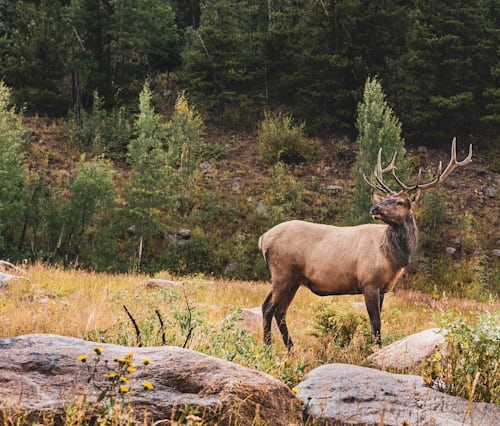As an Amazon Associate I earn from qualifying purchases.
Our Associate portal can be found here
A hauntingly beautiful sound echoes through eerie early morning fog around Pennsylvania. It’s a declaration, warning, a signal against competitive mates, and a cry for help, but its impression is enthralling. You’ll not forget it the first time these testaments of the state’s most prized wildlife cross your ears. So, when do elk bugle in Pa?
Elk bugling in Pennsylvania is a sign of the rut, and it starts when the days become longer. That sounding typically begins around mid-September, carrying through to early or mid-October. It’s part of the attributes of the breeding season, resulting in tuff battles and shoving matches.
It’s tradition for people to come from near and far for Pennsylvania’s seasonal elk bugling showdown. Seasoned hunters will tell you that there’s nothing like the ear-splitting and rib cage resonating bugle, especially when the elk bull is up close; and trust me, you don’t want to miss that. In this article, you’ll find out when the best time to view and hear from these crepuscular animals is when they move more at dusk or dawn.
Where Can I Find Elk in Pennsylvania?
The sound of elk bugling is distinctive, a male display of dominance over other males to improve his mating efforts. It’s a pitch-shifting vocalization that begins with a low grunting sound and rises to a sharp flute-like whistle similar to distortion in an electric guitar’s amplifier. The sound then drops back into a series of grunts to rub in that he’s the king of the harem.

Last year, more than 1500 elk in Pennsylvania State, much of the population inhabiting parts of Clinton, Cameron, Potter, Clearfield, and Elk counties. The population descends from 177 animals trapped elsewhere and released between 1913 and 1926 by the Pennsylvania Game Commission. But way before humans settled in this state, elk lived here with concentrations in the Pocono Mountains and the North Central Area.
The elk species in Pa is Cervus elaphus, which went extinct after being extirpated by the late 1800s throughout its former ranges in New England and New York. It’s also known as European red deer and has been introduced in some other parts of the world, such as South America and Australia sorely for hunting.
Visitors flock to the state of Pennsylvania, especially elk-concentrated towns of Cameron and elk counties, to watch them bugle during the rut. You are, however, reminded to be elk smart, giving them space and not feeding or naming them.
What’s the Best Time to View Elk Bugling In Pa?
Late summer and fall are the best times to see elk bugling in Pennsylvania, around dawn or dusk. That’s the time of year referred to as the elk rut or breeding season, and it peaks between Labor Day and Halloween. During this period, you’ll catch sight of bulls acting fiercely territorial, letting out bugles and battling their counterparts for mating rights.
It’s possible too to see elk other times of the year in Pa, especially on the approach of winter when the animals are on the move. During cold weather, the animals seek out the warmth of trees, so keep their eyes out in heavily wooded areas. When the seasons become warmer, you can still spot them in the area when they seek out the meadows for food.
The best time to see these red deer and hear them bugle is two hours before sunset and two hours after sunset. Elk are large animals, so they’ll always be up and about to feed since they need to eat frequently at all times of the year. The optimal time to plan your trip to Pennsylvania is between September and October, as there’ll be less congestion than at other periods.
Why Do Elk Bugle, and What Happens During Their Rut?
Blame testosterone for the six-week frenzy characterized by elk bull love songs, jealousy, hate, and passion. Confrontation is rife among the males as the mating season relegates the alpha and who isn’t. Their bugling call is a heart-thumping shriek, especially when beheld at near distances, especially the first time you hear it.
Also Read: What Sounds Does a Deer Make?
An elk bull weighs over 800 pounds of pure muscle and sky-high antlers. He has a sharper rack than moose and lacks the overlapping upper lip, which creates an endearing dim look in Bullwinkle. When they’re in the mood for rutting, these pipers can bugle endlessly, sending their call echoing from the far hills. Among the plains and fields, you’ll hear repeating horns sprinkled with lots of ill intentions for any male, even human, that dares approach.

By virtuoso bugling and lots of posing with threatening body language, a hormonal surge compels the bulls to round up as many cows as their herd status allows. Strange rituals such as rolling on his urine or feces will drive the ladies mad, and a binge of breeding and fending off rivals follows.
What sets the Pennsylvania elk apart from its Rocky Mountains counterpart is pursuing their mating rights next to the road in the fall. You can park your car and watch these exhibitionists fighting, mating, and berating each other with melodious bugles. These animals will treat the local’s front lawns as seedy motels, and visitors are known to trample all over the place looking for photo ops.
Can I See Bulls Fighting For Females during the Pa Elk Bugling Season?
Your trip to see elk bugle in Pennsylvania has amenities like hotels with warm showers and viewing stations. There are also open meadows maintained by the state’s gaming commission and the conservation department. You can see bulls and their harems at private farms in the counties, where the bugling gives away a harem’s exact location.
Remember that the best time to see elk bugle is before sunset and after dawn when they are most active. Bulls will do nothing else at these times except monitor their cows and keep letting out resonating bugles. It has to keep sniffing at the females to tell when they come into estrus to necessitate mating, all the time keeping an eye out for rivals.
Often other males will intrude the proceedings at a harem in the hopes of bagging a female for themselves. Bugles will result in a flurry of threatening antler rattling, but fights rarely occur. That’s because bulls can get seriously injured, and they know it, or their antlers could lock, which in the wild could lead to starvation for both combatants. Strangely enough, evolution has taught them these lessons, so don’t expect much blood and gore.
Conclusion
The answer to ‘when do elk bugle in pa?’ is from the second week of September to mid-October. For general viewing of these animals when they’re not engaged in bugling or their rut, choose the period between Labor Day and Halloween for less congested tourism. However, on high volume traffic days, bring your picnic set-up as you may not find a choice parking-to-view spot.
Amazon and the Amazon logo are trademarks of Amazon.com, Inc, or its affiliates.

36 years old, been hunting and fishing my entire life – love the outdoors, family, and all kinds of hunting and fishing! I have spent thousands of hours hunting hogs and training hunting dogs, but I’m always learning new stuff and really happy to be sharing them with you! hit me up with an email in the contact form if you have any questions.



